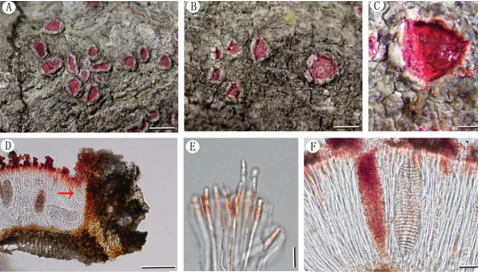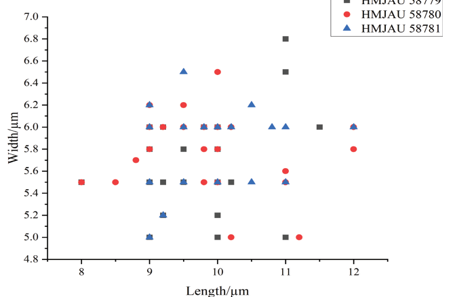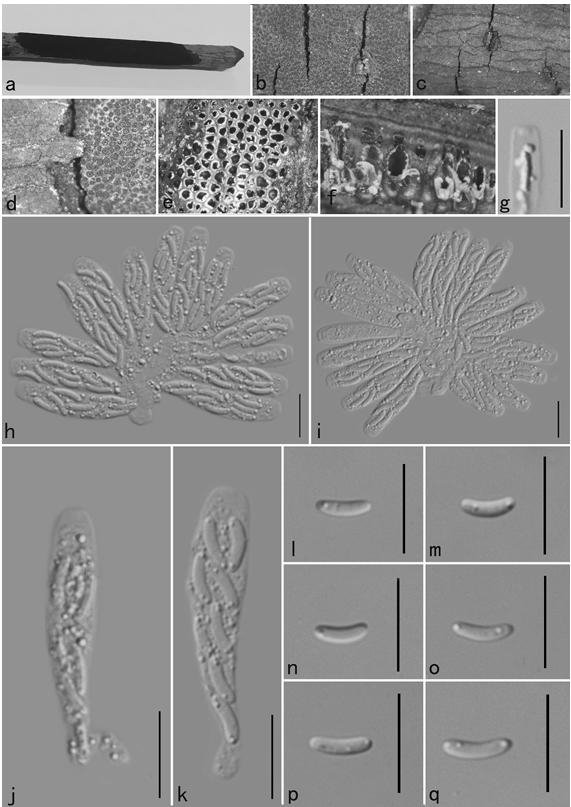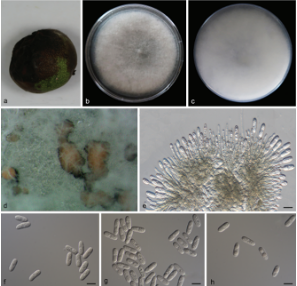Ophiocordyceps liangshanensis H. Yu & Y. Wang, comb. nov.2021
MycoBank MB837859
Holotype: CHINA. Sichuan Province: Liangshan Yi Autonomous Prefecture, Leibo County, alt. 1500 m, on the larva of Hepialidae sp. living in Qiongzhuea tumidinoda forest, 25 July 1980, Jiyuan Li (KUN-HKAS7723, holotype).
Morphological description
Sexual morph:Stromata cylindrical, solid, yellowbrown to brown, 1–2 arising mainly from the head of host, 200–300 mm long, 1.5–2.5 mm wide. Stipes subcylindrical, slender, and long. Fertile parts cylindrical or clavate, yellow-brown to dark brown, covering apex to middle part of stromata, 30–60 mm long, 2–2.5 mm diam., often with a 3–5 mm long sterile apex (n=5). Perithecia dense, superficial, long ovoid, with a basal stipe connected to the stromata, becoming yellowish brown to black brown when mature, 450–740 X 300–450 mm (n=10). Asci hyaline, cylindrical, 8-spored, 260–480 X 8–12 lm (n=10). Apical caps conspicuous and thick, hemiglobose to taper, 7.2–10.0 mm wide, 4.4–6.4 mm high (n=10). Ascospores hyaline, fasciculate, thread-like, slender and long, 170–240 X 2.5–4.1 mm (n=10), with many septa, not breaking into secondary ascospores. Septa, 5.5–19.8 X 2.5–4.1 mm (n =10).
Asexual morphs: Hirsutella. Colonies on PDA growing very slowly, reaching 12–15 mm diam after 2 months at 25 °C, hard, round, irregular swell, brown, and radial growth of white. Cell secretoried dark brown pigment material. Hyphae hyaline, septate, branched, smooth-walled, 3.2–5.4 lm wide (n=10). Conidiogenous cells monophialidic, sometimes polyphialidic with swollen base and slender neck, generating on hyphae laterally or terminally, hyaline, 46.9–75.6 mm long (n=20), smooth and subcylindrical in the basal region, reaching 3.8–4.7 mm wide (n=20), tapering gradually or abruptly to a straight neck, minutely warty, 2.0–3.0 mm wide at the tip (n=20). Conidia hyaline, aseptate, smooth-walled, arising in groups at the apex of the neck, ellipsoid, citri form or shape of an orange segment, 8.0–12.6X3.6–5.0 mm (n=25), single or 2–4 aggregated, embedded in a pigmented mucous sheath.
Habitat: Larvae of Hepialidae sp., reddish dark brown, 31–55 mm long, 6–10 mm wide (n=10).
Distribution: This species is distributed in Sichuan, Yunnan, and Guizhou, southwestern China.
GenBank Accession: LSU MT774227; SSU MT774220; tef1-α MT774248; rpb1 MT774234; rpb2 MT774241.
Reference: Wang, Y. , Dai, Y. D. , Yang, Z. L. , Guo, R. , & Yu, H. . (2021). Morphological and molecular phylogenetic data of the chinese medicinal fungus cordyceps liangshanensis reveal its new systematic position in the family ophiocordycipitaceae. Mycobiology(9), 1-11.
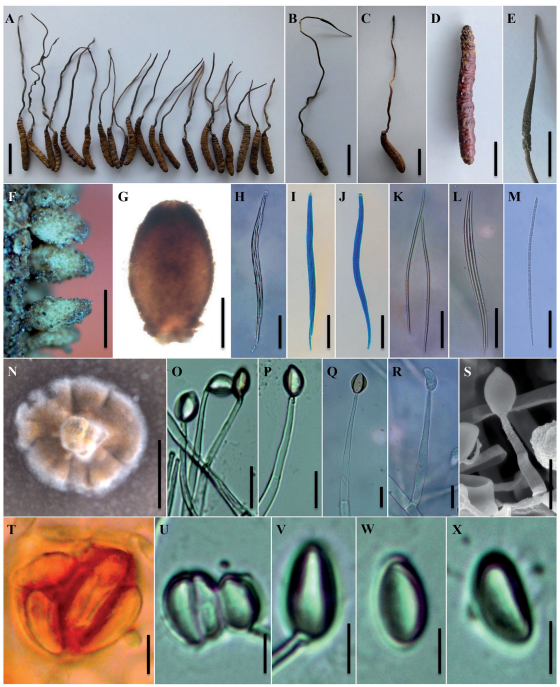
Morphology of Ophiocordyceps liangshanensis. (A) Slender stromata arising from Hepialidae larvae; (B) Mature stroma arising from the larva of Hepialidae. (C) The type specimen of O. liangshanensis (KUN-HKAS7723). (D) The reddish dark brown host of O. liangshanensis. (E) Fertile part; (F–G) Perithecia. (H–J) Asci. (K–M) Ascospores; (N) Colony on PDA; (O–S) Conidiogenous cells; (T–X) Conidia embedded in mucous sheaths. Scale bars: A–C=3 cm; D, E, N=1 cm; F=500 mm; G=200 mm; H–M=50 mm; O–S=10 mm; T–X=5 mm.


